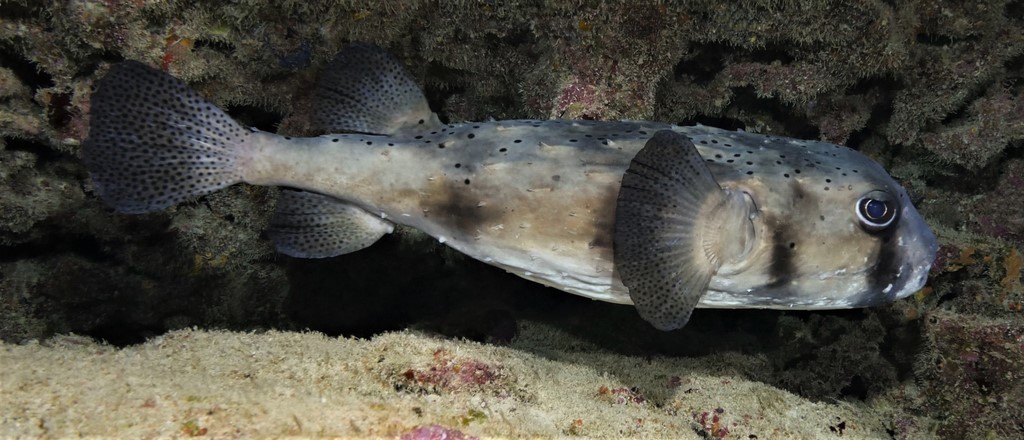CHILOMYCTERUS RETICULATUS - (LINNAEUS, 1758)
Picture courtesy of: Gloup Noumea
Poisson-hérisson ponctué, Poisson porc-épic à nageoires tachetées, Spotfin burrfish, Spotfin porcupinefish, Spottedfin burrfish, Few-spined porcupine-fish, Pez erizo enano, Peixe-porco, Kolvin-klitsvis, Ishigakifugu, イシガキフグ, 강담복, 斑鰭短刺魨,
Synonymes
Chilomycteris reticulatus (Linnaeus, 1758)
Chilomycterus affinis (Günther, 1870)
Chilomycterus atinga (Linnaeus, 1758)
Chilomycterus atringa (Linnaeus, 1758)
Chilomycterus californiensis (Eigenmann, 1891)
Chilomycterus galapagosensis (Klausewitz, 1958)
Chilomycterus lissogenys (Günther, 1910)
Cyanichthys coeruleus (Kaup, 1855)
Diodon atringa (Linnaeus, 1758)
Diodon echinatus (Linnaeus, 1758)
Diodon reticulatus (Linnaeus, 1758)
Diodon tigrinus (Cuvier, 1818)
Euchilomycterus quadradicatus (Waite, 1900)
--------------------------
Description
Dorsal soft rays (total): 12-14; Anal soft rays: 11-14; Pectoral fin rays: 19-22; Caudal fin ray: 10; Vertebrae: 21-23. Head and body with short immovable spines, about 8-10 in an approximate row from snout to dorsal fin; One or two spines on the part of the caudal peduncle; Median fin small, the caudal rounded; Nasal organ of adults an open, ridged cup; No fleshy tentacles extending from spines or anywhere else. All dermal spines fixed in erect position, and base of each spine with at least 3 roots, some spines on top of head with 4 roots; At least one spine situated wholly on dorsum of caudal peduncle. Nostril of adults an open cup with pitted surface, and nostrils of juveniles a short tube with 2 openings. Max. length: 75.0 cm TL. Depth range: 1 - 140 m.
Color
A pale greyish to brown porcupinefish with small dark widely-spaced spots on the head, body and fins, and four diffuse dusky to brown bars, including from the eye running around the throat.
Pelagic juveniles are bluish with dark spots above that extend onto the belly.
Etymology
Chilomycterus: from Greek, cheilos = lip + from Greek, mycterus = nostril. Referring to nostrils having the appearance of two lips, or formed of two tentacles united at the base.
reticulatus: from Latin, reticulum (small net) + from Latin suffix, -ātus = reticulated, net-like. Linnaeus based description on account in Artedi (1738), which itself was based on Willughby (1686), in which fish is described as “muricatus & reticulatus” (spiny & net-like).
Original description: Diodon reticulatus Linnaeus, 1758 - Type locality: India.
Distribution
Circumglobal in warm temperate seas (including Gulf of Mexico; Caribbean Sea; Mediterranean Sea; East China Sea; Sea of Japan; Gulf of California/Mexico).
Biology
Adults found in reefs and over soft bottoms. Often found washed up on beaches. Known to brace themselves against the substrate to sleep at night. Appear to be active during the day. Solitary. Juveniles are pelagic to about 20 cm SL, and may associate with floating algae. Feeds on hard-shelled invertebrates, including large sea urchins. Not usually marketed. The species is occasionally taken in trawl fisheries.
Similar species
Cyclichthys orbicularis (Bloch, 1785) - Reported from New Caledonia.
Cyclichthys spilostylus (Leis & Randall, 1982) - Reported from New Caledonia.
Diodon holocanthus (Linnaeus, 1758) - Reported from New Caledonia - Link to the species (here).
Diodon hystrix (Linnaeus, 1758) - Reported from New Caledonia - Link to the species (here).
Diodon liturosus (Shaw, 1804) - Reported from New Caledonia - Link to the species (here).
Lophodiodon calori (Bianconi, 1854) - Reported from New Caledonia.
Diodon liturosus (Shaw, 1804) - Reported from New Caledonia - Link to the species (here).
Lophodiodon calori (Bianconi, 1854) - Reported from New Caledonia.
Last update: 2, June 2024
